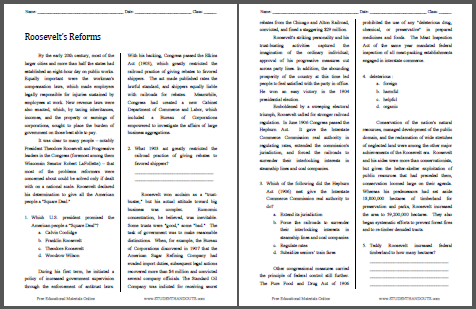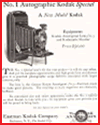| Roosevelt's Reforms Reading with Questions |
|---|
| www.studenthandouts.com ↣ American History ↣ American History Readings |
 By the early 20th century, most of the larger cities and more than half the states had established an eight-hour day on public works. Equally important were the workman's compensation laws, which made employers legally responsible for injuries sustained by employees at work. New revenue laws were also enacted, which, by taxing inheritances, incomes, and the property or earnings of corporations, sought to place the burden of government on those best able to pay.
By the early 20th century, most of the larger cities and more than half the states had established an eight-hour day on public works. Equally important were the workman's compensation laws, which made employers legally responsible for injuries sustained by employees at work. New revenue laws were also enacted, which, by taxing inheritances, incomes, and the property or earnings of corporations, sought to place the burden of government on those best able to pay.It was clear to many people—notably President Theodore Roosevelt and Progressive leaders in the Congress (foremost among them Wisconsin Senator Robert LaFollette)—that most of the problems reformers were concerned about could be solved only if dealt with on a national scale. Roosevelt declared his determination to give all the American people a "Square Deal." During his first term, he initiated a policy of increased government supervision through the enforcement of antitrust laws. With his backing, Congress passed the Elkins Act (1903), which greatly restricted the railroad practice of giving rebates to favored shippers. The act made published rates the lawful standard, and shippers equally liable with railroads for rebates. Meanwhile, Congress had created a new Cabinet Department of commerce and Labor, which included a Bureau of Corporations empowered to investigate the affairs of large business aggregations. Roosevelt won acclaim as a "trust-buster," but his actual attitude toward big business was complex. Economic concentration, he believed, was inevitable. Some trusts were "good," some "bad." The task of government was to make reasonable distinctions. When, for example, the Bureau of Corporations discovered in 1907 that the American Sugar Refining company had evaded import duties, subsequent legal actions recovered more than $4 million and convicted several company officials. The Standard Oil company was indicted for receiving secret rebates from the Chicago and Alton Railroad, convicted, and fined a staggering $29 million. Roosevelt's striking personality and his trust-busting activities captured the imagination of the ordinary individual; approval of his progressive measures cut across party lines. In addition, the abounding prosperity of the country at this time led people to feel satisfied with the party in office. He won an easy victory in the 1904 presidential election. Emboldened by a sweeping electoral triumph, Roosevelt called for stronger railroad regulation. In June 1906 Congress passed the Hepburn Act. It gave the Interstate commerce commission real authority in regulating rates, extended the commission's jurisdiction, and forced the railroads to surrender their interlocking interests in steamship lines and coal companies. Other congressional measures carried the principle of federal control still further. The Pure Food and Drug Act of 1906 prohibited the use of any "deleterious drug, chemical, or preservative" in prepared medicines and foods. The Meat Inspection Act of the same year mandated federal inspection of all meat-packing establishments engaged in interstate commerce. Conservation of the nation's natural resources, managed development of the public domain, and the reclamation of wide stretches of neglected land were among the other major achievements of the Roosevelt era. Roosevelt and his aides were more than conservationists, but given the helter-skelter exploitation of public resources that had preceded them, conservation loomed large on their agenda. Whereas his predecessors had set aside 18,800,000 hectares of timberland for preservation and parks, Roosevelt increased the area to 59,200,000 hectares. They also began systematic efforts to prevent forest fires and to re-timber denuded tracts. Click here to print. Answer Key: (1) C - Theodore Roosevelt; (2) Elkins Act; (3) D - Subsidize seniors' train fares; (4) B - harmful; (5) 59,200,000. |
 |  |  |  |  |
| www.studenthandouts.com ↣ American History ↣ American History Readings |








